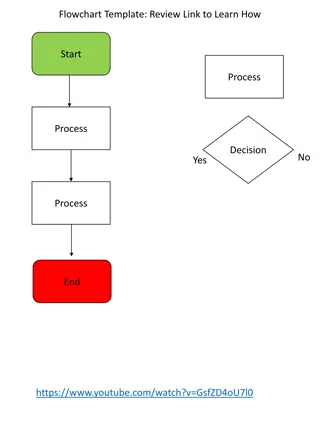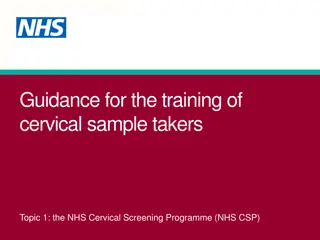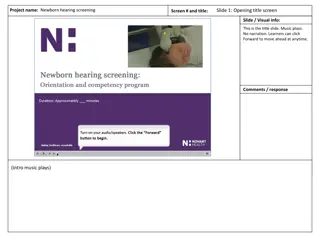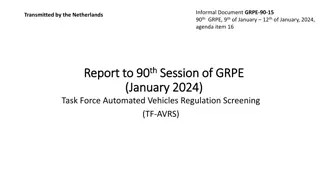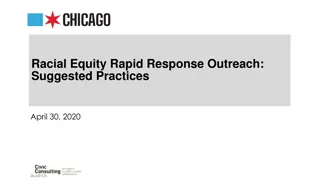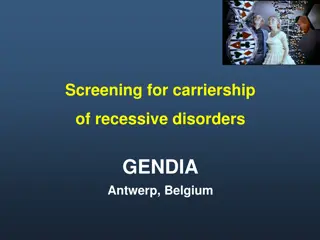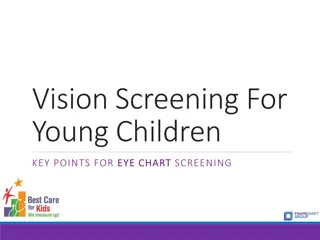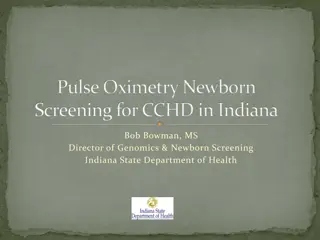
Understanding Screening in Healthcare
Learn about the concept of screening in healthcare, including compute and interpret sensitivity, specificity, predictive values, false positive rate, and false negative rate. Explore screening test results and practice exercises to enhance your understanding of disease detection methods.
Download Presentation

Please find below an Image/Link to download the presentation.
The content on the website is provided AS IS for your information and personal use only. It may not be sold, licensed, or shared on other websites without obtaining consent from the author. If you encounter any issues during the download, it is possible that the publisher has removed the file from their server.
You are allowed to download the files provided on this website for personal or commercial use, subject to the condition that they are used lawfully. All files are the property of their respective owners.
The content on the website is provided AS IS for your information and personal use only. It may not be sold, licensed, or shared on other websites without obtaining consent from the author.
E N D
Presentation Transcript
PERFORMANCE OBJECTIVES Compute and interpret Sensitivity Specificity Predictive value positive Predictive value negative False positive rate False negative rate
Screening is defined as the search for unrecognized disease or defect by means of rapidly applied tools in apparently healthy individuals not seeking medical care
Screening test results Gold standard Diseased a True positive c False negative True negative a+c Total Not diseased b False positive d 4 Positive a+b Negative c+d Total b+d a+b+c+d Sensitivity is ability of the test to detect correctly those who truly have the condition (true positive) = ? ?+? Specificity is ability of the test to detect correctly those who truly don t have the condition (true negative) = ? ?+?
Screening test results Gold standard Diseased a True positive c False negative True negative a+c Total Not diseased b False positive d 5 Positive a+b Negative c+d Total b+d a+b+c+d ? False negative rate = ?+? ? False positive rate = ?+?
Screening test results Gold standard Diseased a True positive c False negative True negative a+c Total Not diseased b False positive d 6 Positive a+b Negative c+d Total b+d a+b+c+d Predictive value positive (Pv+ve) is the probability that a person ? positive by the test truly have the condition = ?+? Predictive value positive (Pv-ve) is the probability that a person ? negative by the test truly don t have the condition = ?+?
A total of 100 barbers were screened Hepatitis C (RIBA) Positive 8 Test (ELISA) Positive Negative Total Total Negative for hepatitis C using ELISA followed by confirmation of the diagnosis using RIBA. Results shows that 57 out of the 59 positive by the ELISA were as well positive by the RIBA and 38 out of the 41 negative by the test were as well negative by the RIBA. Present the data in a suitable table EXERCISE -1
A total of 100 barbers were screened Hepatitis C (RIBA) Positive Negative 57 3 60 9 Test (ELISA) Positive Negative Total for hepatitis C using ELISA followed by Total 2 38 40 59 41 100 confirmation of the diagnosis using RIBA. Results shows that 57 out of the 59 positive by the ELISA were as well positive by the RIBA and 38 out of the 41 negative by the test were as well negative by the RIBA. Identify the true positive, true negative, false positive and false negative cell EXERCISE -1
A total of 100 barbers were Hepatitis C (RIBA) Positive 57 (TP) 3 (FN) 60 screened for hepatitis C using ELISA 10 Test (ELISA) Positive Negative Total Total Negative 2 (FP) 38 (TN) 40 followed by confirmation of the 59 41 100 diagnosis using RIBA. Results shows that 57 out of the 59 positive by the ELISA were as well positive by the RIBA and 38 out of the 41 negative by the test were as well negative by the RIBA. Identify the true positive, true negative, false positive and false negative cell EXERCISE -1
A total of 100 barbers were Hepatitis C (RIBA) Positive Negativ screened for hepatitis C using 11Test (ELISA) Total ELISA followed by confirmation of e Positive Negative Total 57 (TP) 3 (FN) 60 2 (FP) 38 (TN) 40 59 41 100 the diagnosis using RIBA. Results shows that 57 out of the 59 positive by the ELISA were as well Sensitivity Specificity False positive False negative Pv+ve Pv-ve positive by the RIBA and 38 out of the 41 negative by the test were as well negative by the RIBA. Calculate and interpret the sensitivity, specificity, predictive values and errors of the ELISA EXERCISE -1
Calculation of the sensitivity, Hepatitis C (RIBA) Positive 57 (TP) 3 (FN) 60 12 Test (ELISA) Positive Negative Total Total Negative 2 (FP) 38 (TN) 40 specificity, predictive values and 59 41 100 errors of the ELISA (57/60)x 100 = 95% (38/40) x 100 = 95% (2/40) x 100= 5% (3/60) x 100= 5% (57/59) x 100= 98.3% (38/41) x 100= 92.7% Sensitivity Specificity False positive False negative Pv+ve Pv-ve EXERCISE -1
Sensitivity: Hepatitis C (RIBA) Positive 57 (TP) 3 (FN) 60 The test was able to identify correctly 13Test (ELISA) Positive Negative Total Total Negative 2 (FP) 38 (TN) 40 95% of those who have anti-bodies 59 41 100 (indicate previous exposure) against hepatitis C virus (57/60)x 100 = 95% (38/40) x 100 = 95% Sensitivity Specificity False positive (2/40) x 100= 5% False negative Pv+ve (57/59) x 100= 98.3% Pv-ve (38/41) x 100= 92.7% Specificity: The test was able to identify correctly (3/60) x 100= 5% 95% of those who don t have anti- bodies (indicate no previous exposure) against hepatitis C virus Both sensitivity and specificity of the ELISA are high values EXERCISE -1
False positive rate Hepatitis C (RIBA) Positive 57 (TP) 3 (FN) 60 It is the complementary of the 14Test (ELISA) Positive Negative Total Total Negative 2 (FP) 38 (TN) 40 specificity 59 41 100 The test misclassified 5% of the subjects as positive; they are in fact (57/60)x 100 = 95% (38/40) x 100 = 95% Sensitivity Specificity False positive (2/40) x 100= 5% False negative Pv+ve (57/59) x 100= 98.3% Pv-ve (38/41) x 100= 92.7% negative (3/60) x 100= 5% False negative rate It is the complementary of the sensitivity The test misclassified 5% of the subjects as negative; they are in fact positive EXERCISE -1
Predictive value positive Hepatitis C (RIBA) Positiv e 57 (TP) 3 (FN) 60 15 Test (ELISA) Total Out of those who were positive by Negativ e 2 (FP) 38 (TN) 40 the ELISA, 98.3% were positive by Positive Negative Total 59 41 100 the confirmatory test (57/60)x 100 = 95% (38/40) x 100 = 95% (2/40) x 100= 5% Sensitivity Specificity False positive False negative (3/60) x 100= 5% Pv+ve (57/59) x 100= 98.3% Pv-ve (38/41) x 100= 92.7% Predictive value negative Out of those who were negative by the ELISA, 92.7% were negative by the confirmatory test The test has a high yield EXERCISE -1
A study was conducted to evaluate Myocardial infarction Positive 16Ck results Positive 80 IU Negative < 80 IU Total the role of serum creatine kinase Total Negative (CK) in the identification of acute 215 16 231 myocardial infarction (MI) among 15 114 129 360 patients admitted to the ICU 230 130 360 with suggestive symptoms. Results Sensitivity Specificity False positive are presented in the opposite table. False negative Compute and interpret the Pv+ve Pv-ve sensitivity, specificity, predictive values and false rates obtained by the test. EXERCISE -2
The test is suitable for screening because its high sensitivity and predictive value Myocardial infarction Positive 17Ck results positive Total Negative The test is capable to identify correctly Positive 80 IU Negative < 80 IU Total 215 16 231 93.5% of those with MI and 93.1% of those positive by the test have MI. 15 114 129 230 130 360 Its specificity and predictive value negative are still good but lower than (215/230) x 100= 93.5% (114/130) x 100=87.7% Sensitivity Specificity False positive (16/130) x 100=12.3% sensitivity and predictive value positive as CK may be elevated in association with False negative (15/230) x100= 6.5% other conditions. Pv+ve (215/231) x 100=93.1% Pv-ve (114/129) x100= 88.4% Those who receive false reassurance are only 6.5% of those tested negative by the EXERCISE -2 test
The opposite table portrays the Uterine cancer Positiv e 10 5 15 18 Bleeding Total Negativ e 40 45 85 results of confirmation of the diagnosis of uterine cancer among Positive Negative Total 50 50 100 50 women who presented with bleeding and 50% who did not Sensitivity Specificity False positive False negative Pv+ve report bleeding. Compute and interpret the sensitivity, specificity, predictive values and false rates obtained Pv-ve by the test. EXERCISE -3
Bleeding has a low specificity and much lower sensitivity in indicating the presence Uterine cancer Positive Negative 10 5 15 19 Bleeding Total of uterine cancer. Positive Negative Total 40 45 85 50 50 100 Its false positive rate means that nearly 50% of the women will be subjected to a series of investigation at high cost and Sensitivity Specificity False positive (40/85) x 100 = 47.1% (10/15) x 100 = 66.7% (45/85) x 100 = 77.5% they will be negative Like wise, 33.3% of the women who are False negative (5/15) x 100 = 33.3% Pv+ve (10/50) x 100 =20% not presenting with bleeding will receive Pv-ve (45/50) x 100= 90% a false reassurance that they are free On the contrary, the absence of bleeding means a high probability (0.90) that they EXERCISE -3 are free from uterine cancer

